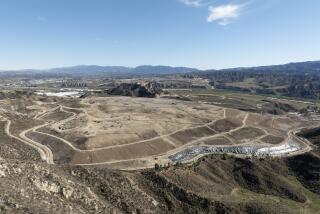Editorial: Close SoCalGas’ facility in Aliso Canyon -- eventually
- Share via
As the natural gas leak in Aliso Canyon continues into its 10th week, its deleterious effects keep growing. Some 1,700 families in nearby Porter Ranch, sickened by the smell, have been moved away to temporary housing, and 1,000 households more have applied for relocation. The Los Angeles Unified School District is planning to move the students from two Porter Ranch schools to temporary classrooms at other sites until the gas flow is stopped, which could take three to four more months. A huge cloud of methane hovers over the area, and the leak is releasing as much greenhouse gas per month as 210,000 cars do in a year.
In the short term ... it’s impossible to close Aliso Canyon without inflicting significant pain on Southern California residents and businesses.
The gas is escaping from an old well in a former oil field that has been converted into the largest underground natural gas storage facility on the West Coast. Until the leak was reported in late October, few people knew about the Southern California Gas Co. facility in the hills north of Porter Ranch, nor did they realize the potential risk. Now, community members are rallying to shut the field down — for good.
That’s the right long-term goal. The entire state must reduce its reliance on natural gas and facilities such as the one in Aliso Canyon. There are risks inherent in operating a major gas field in an urban area, and regulators have not done enough to reduce them. Plus, California has committed to slashing greenhouse gases 80% below 1990 levels by 2050. To reach that target, the state probably will have to slash or even eliminate the use of natural gas and other fossil fuels. The region may also be compelled to stop burning natural gas at some point to meet federal standards for smog and soot.
In the short term, however, it’s impossible to close Aliso Canyon without inflicting significant pain on Southern California residents and businesses. Homes have gas stoves, water heaters, furnaces and clothes dryers. Gas fuels the area’s factories, gasoline refineries and wastewater treatment plants. About half the state’s electricity comes from natural gas-fired power plants.
Some 90% of the natural gas used in California is imported from other states, and the amount that can be moved into the Los Angeles basin by pipeline is less than the region needs during peak demand — typically, the hottest days in the summer when more electricity is needed for air conditioning, and the coldest days in the winter when people crank up the heat. The Aliso Canyon storage field ensures that SoCalGas can meet gas demand at those times, rather than having to cut off customers, while also helping to protect customers against price spikes.
The need for gas today is no excuse for not planning for tomorrow, however. California has to move aggressively to develop renewable energy sources and the infrastructure to support them so we’re less dependent on natural gas. This year, the state Legislature passed new mandates that will help; utilities will have to generate half the state’s electricity from renewables sources by 2030, and the state must double the energy efficiency of homes, offices and factories by that date as well. Those ambitious targets won’t be easy to meet. How can the state encourage more people to power and heat their homes with renewable electricity? How quickly can researchers develop large-scale batteries that can store electricity generated by wind farms and solar panels for use when the wind isn’t blowing or the sun isn’t shining?
Critics of the state’s response to climate change note how expensive it will be to make the switch from fossil fuels, which typically cost less per unit of energy than renewable ones. The forced evacuations from Porter Ranch, however, illustrate the hidden costs of fossil fuels that, once revealed, make the alternatives seem like a bargain. While Southern California isn’t ready to turn off natural gas yet, the Aliso Canyon catastrophe should be a wake-up call about the effects, locally and globally, of our continued dependence on fossil fuels. We should wean ourselves off them as expeditiously as we can. Until then local, state and federal authorities have a responsibility to strictly regulate and oversee oil and gas operations that can devastate a community.
Follow the Opinion section on Twitter @latimesopinion and Facebook
More to Read
A cure for the common opinion
Get thought-provoking perspectives with our weekly newsletter.
You may occasionally receive promotional content from the Los Angeles Times.









